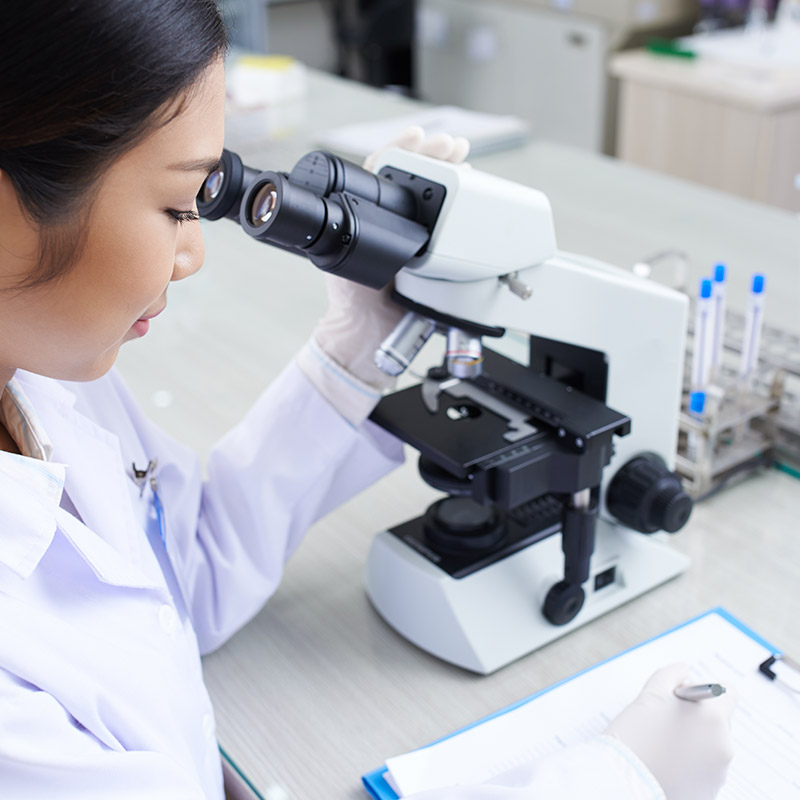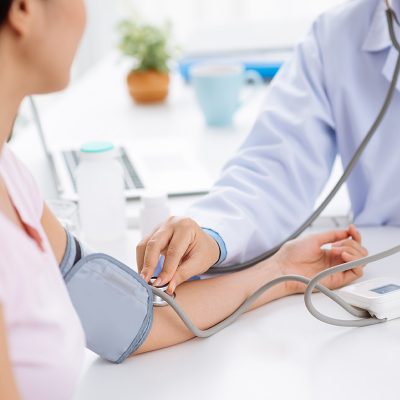Echocardiogram
An echocardiogram is a test performed in the doctor’s office or at the hospital during which ultrasound technology is used to examine the heart. No preparation is required for a resting echocardiogram.
- On the day of the test, you will be asked to lie on the examination table while electrodes are attached to your chest in order to record data from each part of the heart using advanced imaging techniques.
- The echocardiogram administrator will take recordings of different parts of the chest, so that multiple views of the heart are available.
- You will be instructed to move from your back to your side and asked to breathe slowly or hold your breath at different points, as this is helpful in obtaining images of a higher quality.
Images taken of the heart can be viewed on a monitor by your healthcare provider. The images are also printed on photographic paper and recorded for your permanent records. Your echocardiogram will be examined and the findings thoroughly reviewed by your physician before results are given and a diagnosis is made.

Electrocardiogram
An electrocardiogram, also known as an EKG, is a noninvasive test performed in the doctor’s office or at the hospital to detect problems with the heart. The most common problem found using an EKG is a heart arrhythmia.
- During an EKG, small electrodes are taped to your chest, arms and legs. These electrodes are connected to a machine that monitors and measures the electrical activity of your heart.
- You will need to lie flat on your back, stay very still and breathe as you normally would during the procedure. You should not talk during the EKG, and your doctor might ask you to hold your breath for a few seconds.
- An EKG should only last between 5 to 10 minutes.
The readings from the test translate the heart’s electrical activity to lines on paper. The dips and spikes of the line show the electrical current as it runs through each of the four chambers of your heart. Your doctor will exam your electrocardiogram before giving you results or making a diagnosis on whether your heart’s rhythm is normal.

Holter Monitor Testing
Holter monitor testing is done in order to observe cardiac irregularities, check pacemaker functioning or examine the effectiveness of heart medications. A Holter Monitor is a machine that will record the rhythm of your heart for 24-hours or longer. The monitor is worn throughout the day and night in order to provide more data than a standard electrocardiogram. The monitor is attached to your chest with electrodes and includes a small box that will record the data and store heart rhythm/rate numbers.
It only takes about 15 minutes for your Holter monitor to be hooked up, and there is no preparation necessary. While wearing your Holter monitor, you are encouraged to continue with your normal daily activities, however, you will need to avoid getting wet!




Echocardiogram
An echocardiogram is a test performed in the doctor’s office or at the hospital during which ultrasound technology is used to examine the heart. No preparation is required for a resting echocardiogram.
- On the day of the test, you will be asked to lie on the examination table while electrodes are attached to your chest in order to record data from each part of the heart using advanced imaging techniques.
- The echocardiogram administrator will take recordings of different parts of the chest, so that multiple views of the heart are available.
- You will be instructed to move from your back to your side and asked to breathe slowly or hold your breath at different points, as this is helpful in obtaining images of a higher quality.
Images taken of the heart can be viewed on a monitor by your healthcare provider. The images are also printed on photographic paper and recorded for your permanent records. Your echocardiogram will be examined and the findings thoroughly reviewed by your physician before results are given and a diagnosis is made.
Electrocardiogram
An electrocardiogram, also known as an EKG, is a noninvasive test performed in the doctor’s office or at the hospital to detect problems with the heart. The most common problem found using an EKG is a heart arrhythmia.
- During an EKG, small electrodes are taped to your chest, arms and legs. These electrodes are connected to a machine that monitors and measures the electrical activity of your heart.
- You will need to lie flat on your back, stay very still and breathe as you normally would during the procedure. You should not talk during the EKG, and your doctor might ask you to hold your breath for a few seconds.
- An EKG should only last between 5 to 10 minutes.
The readings from the test translate the heart’s electrical activity to lines on paper. The dips and spikes of the line show the electrical current as it runs through each of the four chambers of your heart. Your doctor will exam your electrocardiogram before giving you results or making a diagnosis on whether your heart’s rhythm is normal.
Holter Monitor Testing
Holter monitor testing is done in order to observe cardiac irregularities, check pacemaker functioning or examine the effectiveness of heart medications. A Holter Monitor is a machine that will record the rhythm of your heart for 24-hours or longer. The monitor is worn throughout the day and night in order to provide more data than a standard electrocardiogram. The monitor is attached to your chest with electrodes and includes a small box that will record the data and store heart rhythm/rate numbers.
It only takes about 15 minutes for your Holter monitor to be hooked up, and there is no preparation necessary. While wearing your Holter monitor, you are encouraged to continue with your normal daily activities, however, you will need to avoid getting wet!
Stress Testing
Cardiovascular Health & Stress
A stress test gauges a patient’s cardiovascular health by recording heart rate, blood pressure, oxygen intake and other factors while the patient experiences increasing heart stimulation, either through strenuous exercise in a controlled environment or through intravenous drug stimulation. The patient’s resting coronary circulation is recorded and then compared to their circulation recorded during the stimulation period.
If your stress test involves physical activity, you will be asked to walk/jog on a treadmill while the treadmill’s slope steepness and speed are progressively increased. If your stress test involves intravenous drug stimulation, depending on other medications you are currently taking, you will be given one of the following pharmaceuticals: Dobutamine, Adenosine or Dipyridamole. Please be sure your doctor has a list of your current medications to ensure a reaction will not occur.


Preparations for a Cardiac Stress Test
For several hours leading up to the stress test, we ask that patients not eat, drink or smoke. Please also refrain from drinking caffeine or alcohol at your last meal before your test.
If you are doing an exercise stress test, please wear appropriate athletic clothes and shoes to the office. If you do not have athletic clothes, we suggest wearing a comfortable, loose-fitting T-shirt and shorts or pants. We also advise that you do a few stretches to prevent cramps while on the treadmill.
If you are doing a pharmacological stress test, please bring your current cardiac medications and/or inhalers with you. We will review these medications to determine which drug you will be administered for the test.
Side Effects from a Cardiac Stress Test
After completing an exercise stress test, some patients experience side effects, including:
- Heart palpitations
- Chest pain
- Shortness of breath
- Headache
- Nausea
- Fatigue
Side effects from a pharmacological stress test may include mild hypertension caused by the Adenosine or Dipyridamole.


Venous Insufficiency Testing
Veins carry blood from the organs and body tissues to the heart. They are susceptible to a variety of disorders, including varicose veins, spider veins and chronic venous insufficiency (CVI). If not treated, these conditions do not go away; they only get worse over time. Testing can ensure accurate diagnosis and treatment.
Venous insufficiency testing consists of a physical exam and a discussion of your medical history, as well as a vascular or duplex ultrasound to assess the circulation of blood in your legs. An ultrasound provides a detailed image of your condition, and is essential because not all vein diseases are visible on the surface of the skin.
Following testing, your cardiologist will discuss procedures that will best treat your conditions.
Results
If there is any irregular blood flow in the heart during the stimulation period, this could indicate that the patient has ischemic heart disease, coronary artery stenosis, angina pectoris or is at high risk for a heart attack.

